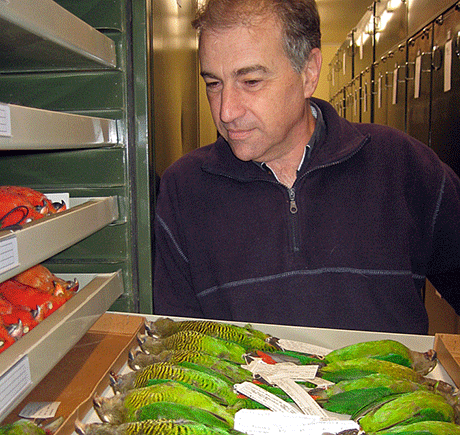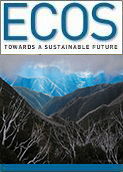
|
Published: 23 December 2013
In search of evolution's footprint
What kinds of wildlife do we have on this continent? Where are these species found? How have they evolved? How are they related to wildlife in other parts of the world? And how can we conserve this natural heritage for future generations? These are some of the questions that the Director of Australia’s largest wildlife collection wrestles with in the course of his work.

|
|
A lifelong interest in birds has led Dr Leo Joseph to study the relationship between and within species over space and time. Credit:
scienceimage/CSIRO
|
I’m sitting down to have a chat with Leo Joseph, Director of the Australian National Wildlife Collection (ANWC) in Canberra, the Australian National Wildlife Collection, when a staff member bursts into the office. He’s holding a dead bird in his hands. The bird has been dissected.
‘Leo,’ he says, ‘I think this one’s been mislabelled. They’ve got it down as adult, but it’s got a bursa.’ At the ANWC, everything stops for accurate taxonomic identification.
Dr Joseph is a bird expert who’s been smitten since childhood, when he found his attention drawn to parrots in the local Adelaide Hills.
These days, his special interest is the use of DNA-based methods to investigate bird species’ evolutionary history, in particular the relationships between groups of closely related species across the landscape.
Among the many scientific journal papers and books Dr Joseph has authored or co-authored are Boom or Bust: Bird Stories for a Dry Country and Stray Feathers: Reflections on the Structure, Behaviour and Evolution of Birds.
Back at the ECOS interview, Dr Joseph peers at the dissected bird’s internal organs. ‘Yes, it definitely looks like a bursa.’ (The bursa of Fabricius, found only in very young birds, is a round outgrowth on the lower intestinal tract; it is involved in the development of the immune system.)
With the matter resolved, we get back to the bigger picture. We talk about the ANWC – what’s in it, the origins of specimens, what the collection is used for, and its current research focus.
It’s a large collection, about 200,000 specimens all up, and not just stuffed animals – although there are quite a few of those.
Along with more traditional museum specimens – preserved skins, skeletons, whole animals in jars of alcohol, and stuffed animals – the ANWC has around 30,000 cryo-frozen tissue samples of Australian and Papua New Guinean vertebrates (largely birds), and vertebrate sub-fossils (the remains of long-dead creatures that have not yet fully fossilised). These sub-fossils provide an insight into conditions in Australia before Europeans arrived.
Then there are the recordings. ANWC’s Sound Library of Australian Wildlife has about 60,000 wildlife sounds captured in a variety of media, many of which have been shared with the Atlas of Living Australia.
Many items in the collection have been donated by members of the public. WIRES (the Wildlife Information, Rescue and Education Service Inc) sends specimens, as does the RSPCA.
The ANWC also undertakes targeted collecting trips – there were two in 2013, to Queensland and PNG.
It’s not just rarities the ANWC is interested in. One of the functions of the collection is to develop a record of the environment across time, and collecting bird specimens is a way to do that. Even feather specimens from the crimson rosella, a common bird in some states, can play their part. Birds’ feathers retain a chemical ‘signal’ that can tell us about the environment at the time in which the animal was living.
This chemical signal works in a similar way to the well-established technique of carbon-14 dating. While carbon-14 dating makes use of the decay rate of an unstable isotope to calculate the age of a specimen, it turns out the ratio of stable isotopes can also reveal a story. The ratio of these isotopes in a bird’s feathers changes depending on its diet and environment: the story of where it’s been and what its food sources were.
Evolutionary biologists like Dr Joseph can use this information to build up a picture of environmental change. For example, by assaying the feathers of seabirds collected some 60 years ago with those of today, North American researchers have found that some species, which used to eat fish, are now finding prey further down the food chain.
Dr Joseph points out that the ANWC’s focus is now moving towards phylogenomics – using data from species’ genomes to uncover the course of evolution over millions of years to determine how a species’ ecological diversity has evolved and how it is still evolving. To put it another way, data from specimens in the collection provide a basis for gene studies that allow us to see ‘evolution in action’.
Surprisingly, molecular biology has revealed we know rather less about Australian reptiles and mammals than we previously thought. In some cases, populations of animals assumed to be the same species, geographically separated, turn out to be distinct species and, in at least one case, may even be a separate genus.
As Dr Joseph points out, although Linnaean taxonomy has served scientists well for a long time, it is a blunt instrument. Today however, by bringing molecular data to the challenge of classifying species, scientists can look past the superficial resemblances that once formed the basis of speciation. This has allowed them to find that resemblances between species may, in some cases, be the product of separate phylogenetic lineages leading to a similar-looking result.
It’s not just physical resemblance that misleads us, says Dr Joseph. Names can too.
When Europeans were getting around to naming Australian birds centuries ago, the names reflected the birds’ similarities to European birds. So we have Australian robins, Australian wrens and so forth.
It wasn’t until 1985 that biologists discovered the naming was the wrong way round: these birds seem to have evolved in the southern hemisphere, and those northern robins and wrens evolved from lineages that migrated from the south.
This confusion has a taxonomic consequence – misguidedly importing a name can lead to false underlying assumptions about species that take a long time to rectify. And this, in turn, can lead to decision-makers misunderstanding ecological diversity and appropriate conservation strategies.
As Dr Joseph puts it so vividly, analysing the evolutionary tree at the molecular level enables us to ‘pull away the appearance and see the footprints on the beach’.



